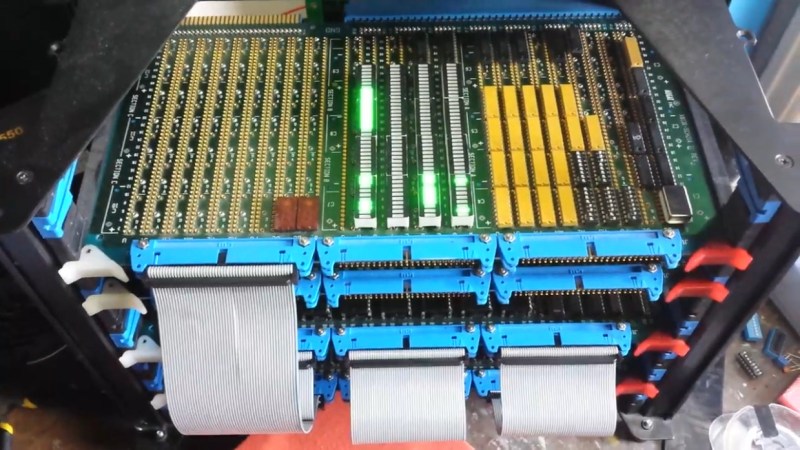Breadboard 8-bit computer builds seem all the rage these days, and with good reason: building your own CPU from the board up using discrete logic chips is a great way to really learn how microprocessors work. Not to mention that it’s an incredible flex. But once you’ve conquered the eight-bit, what do you do? Easy: build a 16-bit computer from 74HC logic chips.
Attentive readers will likely remember this computer’s builder, [Paulo Constantino], from his previous work on 8-bit breadboard computers. As gloriously entropic as that tangled mass of wires was, it must have been a nightmare for [Paulo] to maintain. And so when the time came to upgrade, he wisely chose a more integrated construction method. The construction method is wire-wrapping, with multiple cards plugged into backplane and connected by ribbon cables. The whole card cage is far neater than the previous build, and seems to lend itself to rapid modifications. The top card in the cage acts as a control panel for now; eventually, [Paulo] planes to put a real front panel on the cage to support all the switches and blinkenlights such builds demand. Stretch goals include supporting audio and video and getting the machine online so anyone can log in.
The video below is an overview of the current state of the machine; earlier videos in the playlist cover the design and build in more detail. We hope to see schematics soon, and we’d love to know where to get some of those wire-wrap PCBs for projects of our own.
















Wow, I’m spitballing $600 in ICs and $3000 in sockets…. though I’m not seeing much wrap there.
The wire wrapping is done on the underside of the boards. Those things that look like raised vias that the chips are socketed into are the female ends of the wirewrap pins.
Schematic on his GitHub page.
https://github.com/Pconst167/dreamcatcher
https://raw.githubusercontent.com/Pconst167/dreamcatcher/master/SCHEMATICS.png
Video walk-through Of schematic:-
https://m.youtube.com/watch?v=tJkVvMbwl90
… and his Hackaday project page:-
https://hackaday.io/project/93832-codename-dreamcatcher-16bit-minicomputer
Just wow!
For those interested in this kind of topic, I highly recommend checking this course out:
https://www.nand2tetris.org/
Hi Dan! Thanks for the write up! When the computer is connected to the internet, and hosting its own schematics, I will make a proper video and perhaps send again. I feel I should have waited a little more. But anyhow, at least people know. The purpose is to spread knowledge around. I think our world really needs some inspiration.
Good to see you are actually creating something here instead of throwing mud at our take on a TTL computer at every possible occasion. Keep putting your energy in the system and hopefully it will grow into something even better.